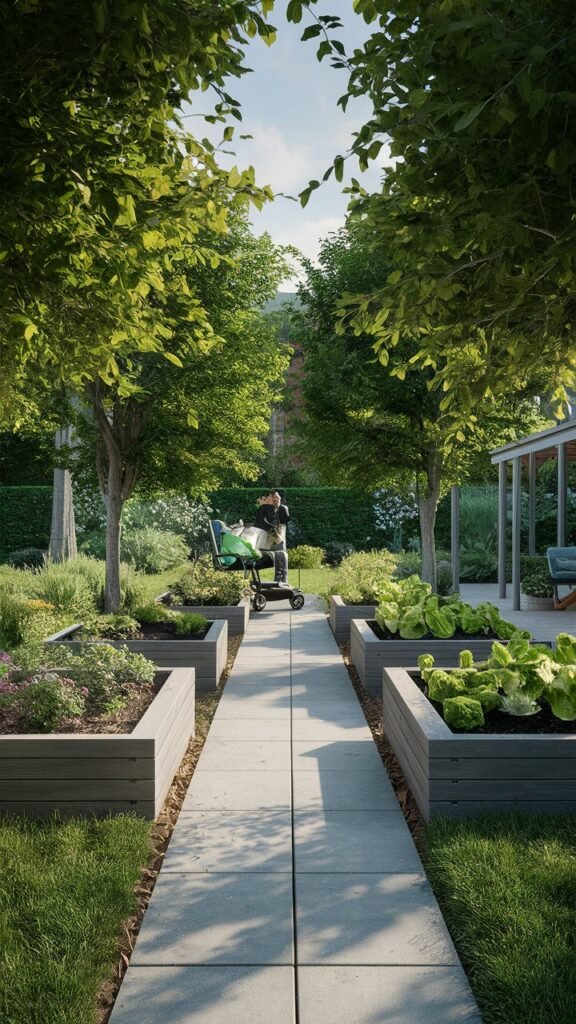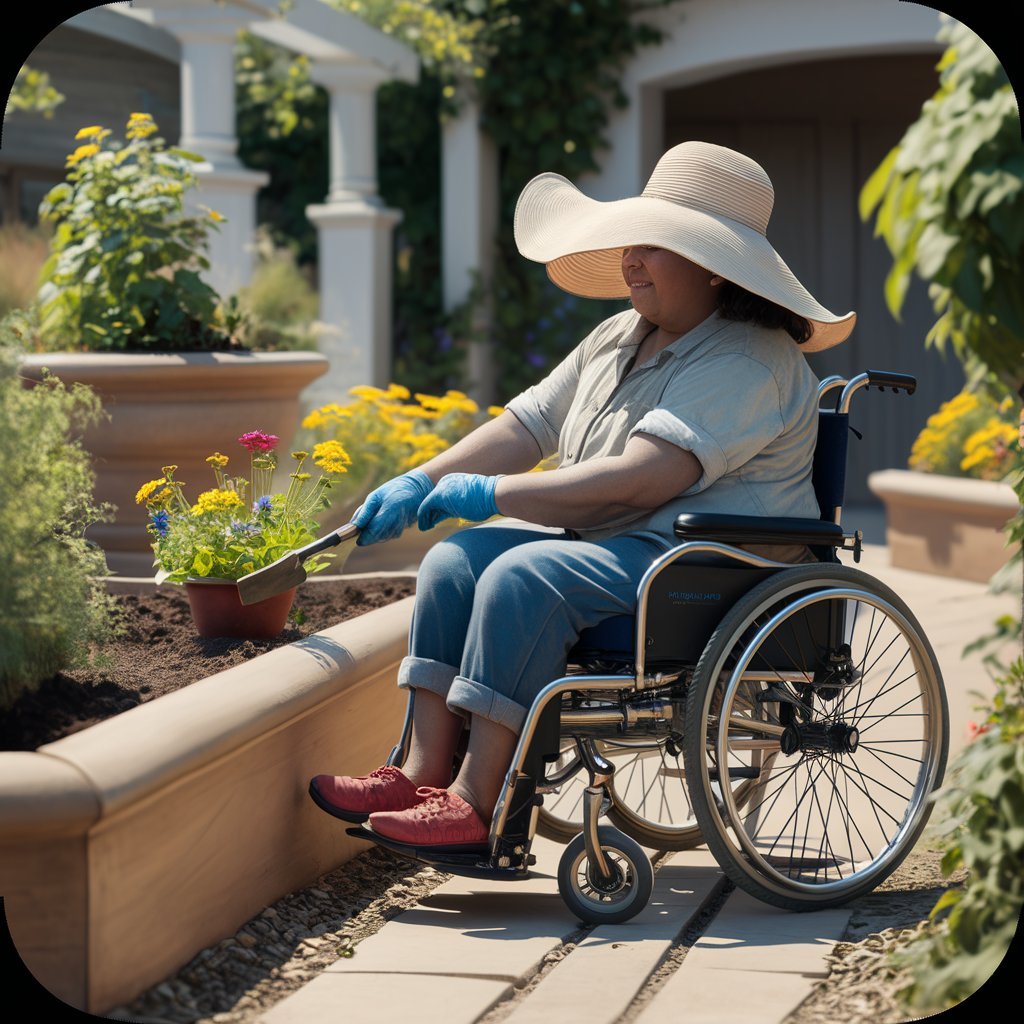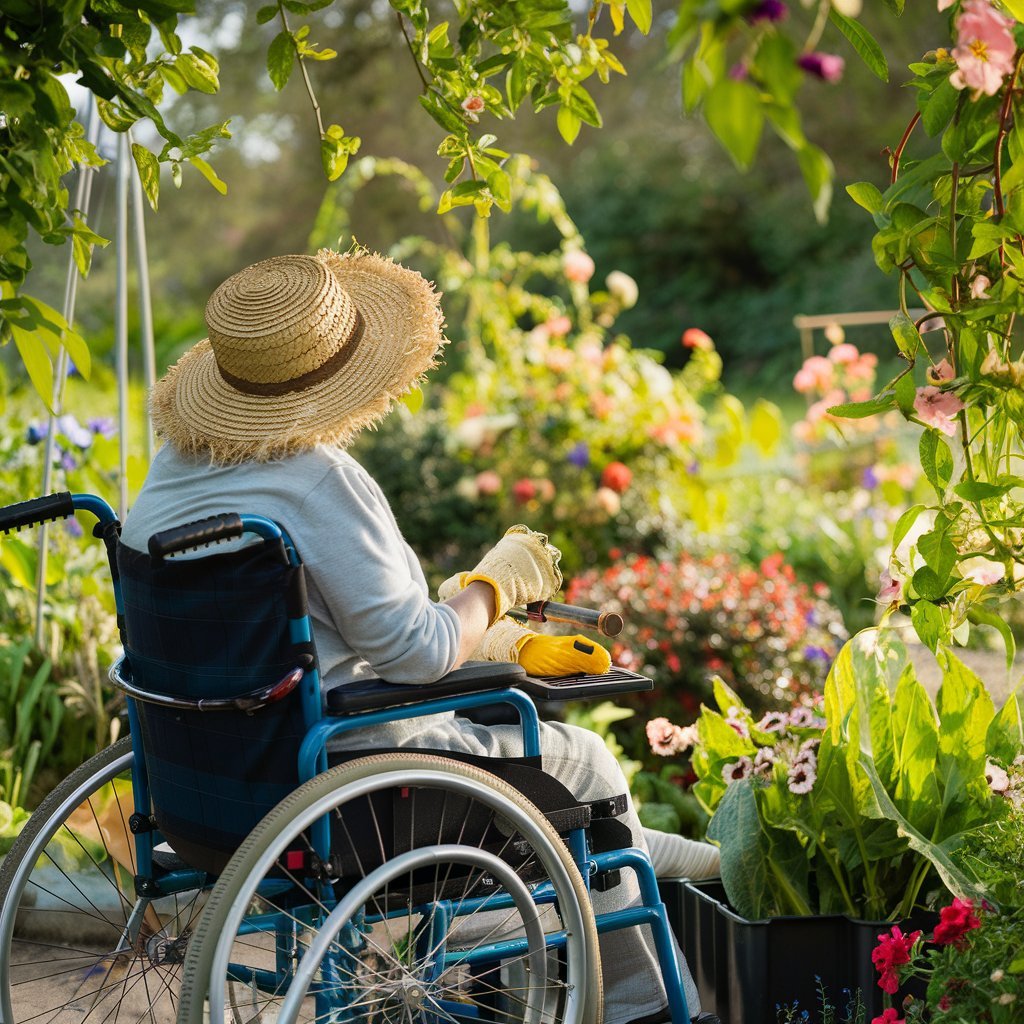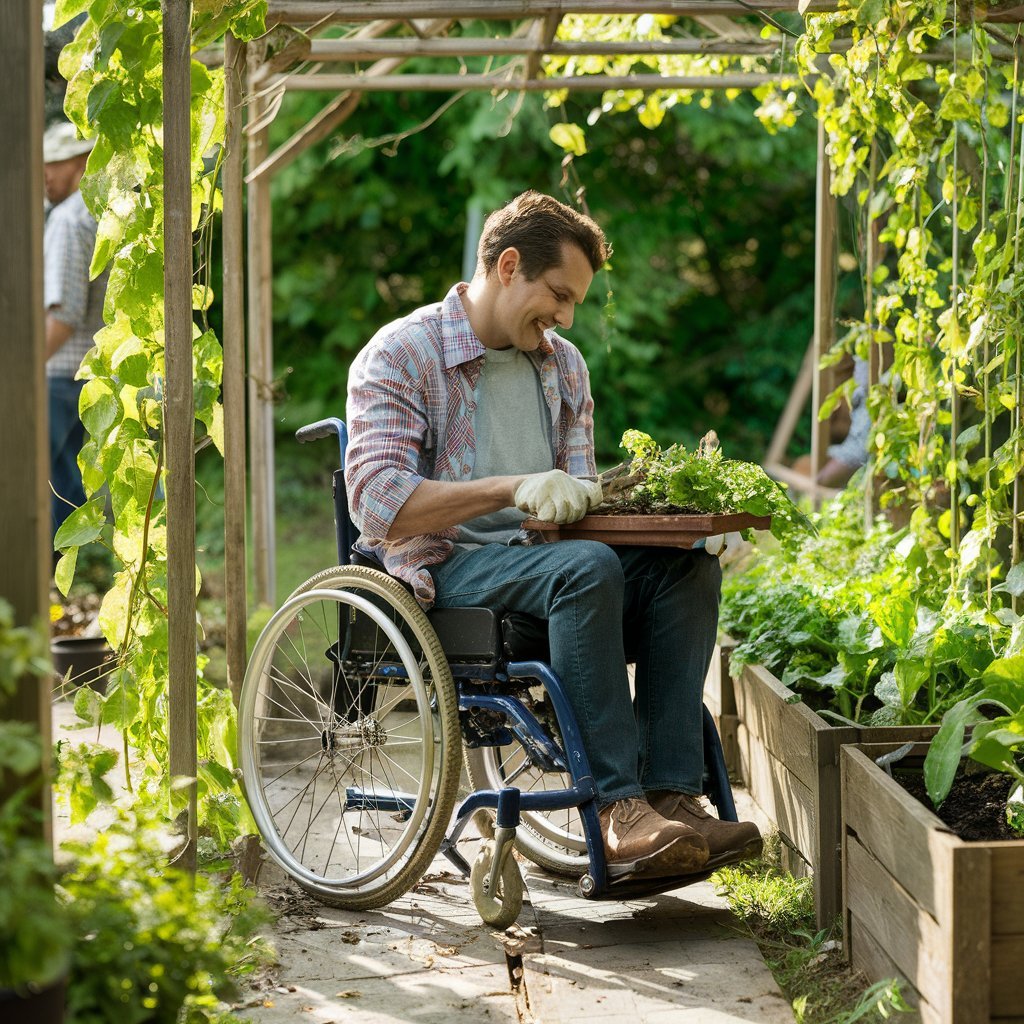Creating gardens that are easy to get to can make small raised beds welcoming for people with disabilities1. These gardens are becoming more common in our homes. They show how gardening can be adapted for everyone, offering both therapy and independence. The University of Minnesota Extension suggests that tabletop gardens should be about 27 inches high. This height helps people in wheelchairs garden easily, avoiding common garden obstacles1.
Inclusive gardens are more than just pretty; they let everyone, no matter their abilities, enjoy nature. By adjusting garden bed heights to 24 inches for seated people and 30 inches for standing, everyone can garden. This way, gardening becomes a fun activity for everyone, including teaching kids about nature.
Accessible pathways, at least 4 feet wide, and solid seating ledges make these gardens comfortable and stable for everyone12. These features ensure that everyone can garden, no matter their abilities.
Key Takeaways
Learn the standard sizes for raised beds and tabletop gardens that meet different needs.
Start with adaptive gardening techniques, including the right heights and widths for comfort and accessibility.
Understand the importance of wide pathways and seating in garden design for everyone’s comfort.
Discover how adjustable features make gardens friendly for people with disabilities.
Learn about the benefits of sensory stimulation and the healing effects of gardening with disabilities.
Understanding Accessible Garden Design Principles
Gardening should be fun for everyone. That’s why universal design is important. It makes gardens welcoming and easy to use for all, regardless of ability.
The Importance of Universal Design in Gardening
Universal design in gardens welcomes everyone. It lets people with different abilities enjoy the same fun experiences. For example, raised beds are designed for gardeners who sit or stand.
Smart placement of features like trellises and green walls helps too. They cater to users of all heights. This approach follows ADA guidelines and improves garden functionality. As a result, gardens become welcoming for all.
Integrating ADA and Universal Design Guidelines
Combining ADA guidelines with universal design is key for accessible gardens. Features like stable pathways and ramps with the right slope are essential. They keep the garden safe and easy to move around in.
It’s also important to place garden beds near water, entrances, and tool storage. This makes the garden practical for therapeutic gardening. It ensures people with disabilities can garden easily.
Creating Sensory Gardens for Therapeutic Effects
Sensory gardens are vital for therapy in gardening. They use various textures, scents, and colors to engage the senses. This interaction has healing effects.
These gardens include features like accessible containers and tabletop beds. They are especially helpful for those with visual impairments. They enhance the sensory experience in a meaningful way.
Feature Benefit ADA Compliance
Raised Beds Allows gardening at optimal height for reduced strain Yes
Pathway Material Ensures slip resistance and stability Stone dust, Grass pavers.
Accessible containers Enhances reach-ability and ease of use in gardening Recommended

Gardening Tools Adapted for Limited Mobility
People with mobility challenges can still enjoy gardening. Special gardening tools make it easy and fun. These tools reduce hard work and let gardeners with limited mobility care for their gardens.
Long-reach tools are great for those who garden sitting down or without bending. Tools like extended pruners and loppers are longer to reach far and make cutting easier. For example, some loppers can be extended from 27 inches to 40 inches. This makes trimming higher branches easy.
Raised garden beds make gardening accessible too. They measure 48x24x30 inches and can hold up to 200 pounds6. Garden liners help these beds last longer and are easy to care for.
Tool Type Description Benefits
Extended Reach Hoe and Cultivator Suitable for working in tight areas Reduces bending and reaching
Retractable Garden Hose Wall-mounted for easy access Decreases the effort needed for watering
Claw Gardening Gloves Make digging and weeding easier Supports those with diminished hand strength
Ergonomic Hand Tools Curved grips for easier handling Ideal for gardeners with limited hand control
Resources for gardeners with limited mobility are provided by folks like NCHPAD. They link gardeners to adaptive tools and methods. This shows how key accessible gardening is for health and happiness in the disabled community.
Container and vertical gardening are also top choices. They make caring for plants easier by reducing bending. With pots on wheels and tall garden beds, gardening becomes less of a strain and more joyful.
In the end, adaptive gardening tools help those with limited mobility. They turn gardening from a hard task into a fun hobby. By selecting the right tools, your garden becomes a source of joy, not discomfort. This proves that disabilities don’t stop someone from growing and nurturing life.
Designing Inclusive Garden Spaces for Engagement
Creating a garden that everyone can use is about more than making it work. It’s about making every part of the garden open to all, no matter how they move.
This means using gardening ways that fit all kinds of abilities. It makes gardening a shared, fun activity for everyone.
Making Garden Beds Accessible for All
Raised beds are key in making gardens easy for everyone to use. They’re designed for different heights and abilities, like for people in wheelchairs7. By thinking about mobility, these beds make sure everyone can join in. This shows that gardens welcoming to all kinds of people.

Paths and Navigation for Wheelchair Accessibility
Walkways are important for making a garden welcoming. They need to be wide enough for everyone, including those in wheelchairs or using walkers. They should also be safe to walk on, without slipping. Ramps are needed wherever the ground level changes, making it easy for everyone to explore the garden’s different areas.
Adjustable Features for Varying Abilities
Gardens should have features that everyone can use, no matter their ability. Things like the height of planters or handles on tools can make a big difference. These help lessen tiredness and make gardening more enjoyable. By planning for people’s needs as they age or if their abilities change, everyone can have fun gardening.
Feature Accessibility Focus Details
Raised Beds Height Accessibility Caters to wheelchair users and varied physical capabilities.
Pathways Width and Texture Minimum of 5 feet wide, textured for safe movement.
Adaptive Tools User-friendly Design Tools designed to accommodate limited mobility and reduce fatigue.
When designing your garden, remember it’s more than adding features. It’s about showing commitment to a garden that welcomes everyone. This means making sure all people can take part in gardening.
Choosing the Right Plants for an Accessible Garden
When picking plants for an accessible garden, it’s important to choose ones that everyone can enjoy. You should look for plants that are easy to care for, can stimulate the senses, and work well with different planting styles. This approach makes the garden both pretty and practical.
Selecting Low-Maintenance and Sensory-Stimulating Plants
For those who have little time or find it hard to move around, picking plants that are easy to look after is key. These should fight off pests and diseases, need less water, and don’t require much cutting. This way, gardening is less of a hassle and more fun.
Adding plants that have sweet smells, interesting textures, and bright colors makes the garden a treat for the senses. This not only makes the garden a lovely place to be but also helps people relax and feel good.

Vertical Gardening and Elevated Planters
Using vertical gardening and tall planters is a smart way to use space wisely and avoid bending or stretching too much. Growing plants on things like trellises or in green walls lets gardeners work at a good height. Make sure raised beds are high enough for wheelchair access, between 24 and 36 inches.
This not only makes gardening easier but also brings an interesting look to your garden area.
Planning for Seasonal Changes and Ongoing Care
It’s important to plan your garden so it stays beautiful all year. Choosing plants that bloom at different times keeps the garden looking fresh. Using the right tools can also make garden care enjoyable rather than tough work.
Paths should be wide, at least 40 inches, with smooth grounds and easy slopes for better access. Using containers at different levels helps people with various physical abilities and can be moved if needed.
Gardening with Disabilities: Creating accessible garden spaces
Making gardens accessible is about more than just removing barriers. It’s about ensuring everyone can experience the healing joys of gardening. We’ll look at how to make gardening inclusive for all.
Case Studies: Success Stories in Accessible Garden Projects
Successful inclusive gardens show the benefits of adaptive gardening. Schools create gardens that welcome students with various needs, including Autism and Dyslexia. They use tools like Google Sketch Up for precise, accessible designs. These designs also provide sensory stimulation for different needs.
Building a Community Around Inclusive Gardening
Inclusive gardening brings people together. It allows for socializing and feeling pride in one’s achievements. By involving everyone, it strengthens community bonds and spreads knowledge about accessible gardening.
Technology and Innovations in Accessible Gardening
Modern technology is changing garden design for the better. Features like automatic doors and 3D printed tools make gardening accessible for all. Companies offer specialized garden beds for those with physical challenges, enhancing the gardening experience.
Feature Benefit Technology Used
Automated watering systems Reduces physical strain and ensures consistent moisture Programmable timers, mobile apps
Raised garden beds Accessibility for wheelchair users and reduces bending Accessible Gardens’ modular designs
Wide, smooth pathways Ensures easy navigation for all abilities Concrete with smooth finishes and gentle slopes.
Adaptive gardening tools Enhanced comfort and usability for limited mobility Easi-Grip tools, ergonomic designs.
With the right ideas and tech, your garden can be both functional and therapeutic. It becomes a welcoming place for everyone.
Conclusion
Making your garden friendly for everyone is key. By adding things like raised beds and wide paths, you help everyone enjoy gardening. These changes are simple but make a big difference. With tools easy to hold and cozy spots to sit and enjoy the view, gardening becomes a fun group activity.
Using deep planters and tools that are easy to use can make gardening a breeze. Features like color contrasts help those with vision problems. This makes your garden not just accessible, but a joy for all senses.
When you focus on making gardening easy for those with disabilities, you’re doing something amazing. You’re not just building a garden. You’re creating a welcoming space where everyone can connect with nature. Let your garden be a celebration of diversity and inclusion.

My name is Michelle Warren, and I’m the founder of Peaceful Gardening. As a 10-year breast cancer survivor, I’ve discovered the profound therapeutic power of gardening. This journey has not only helped me recover but has also become my passion and a source of ongoing peace and joy.
Peaceful Gardening was born from my desire to share the healing benefits of gardening with others. Whether you’re facing health challenges, dealing with stress, or simply looking to connect more deeply with nature, this space is for you.
Over the past decade, I’ve cultivated not just plants, but a deep understanding of how gardening can positively impact mental health. I’ve worked with local community gardens, led workshops on mindful gardening practices, and collaborated with mental health professionals to develop gardening-based stress reduction programs.
Peaceful Gardening was born from my desire to share the healing benefits of gardening with others. Whether you’re facing health challenges, dealing with stress, or simply looking to connect more deeply with nature, this space is for you.
Here, you’ll find evidence-based advice on using gardening as a tool for mindfulness, stress relief, and emotional healing. I share personal stories, practical tips, and scientifically-backed information on how to create your own therapeutic garden space, no matter the size of your yard or balcony.
My mission is to help you discover the joy, peace, and healing that comes from nurturing plants and connecting with nature. Join me in exploring how the simple act of tending to a garden can transform your mental and emotional wellbeing.
Welcome to Peaceful Gardening – let’s grow together towards better mental health!”

